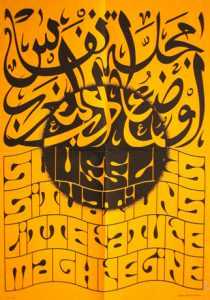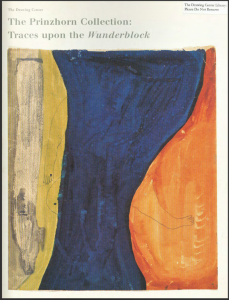Souffles-Anfas; Roz Chast; Shapereader; Mary Wept Over the Feet of Jesus; The Prinzhorn Collection
—————————————————————————————————
Souffles-Anfas: A Critical Anthology from the Moroccan Journal of Culture and Politics
by Olivia C. Harrison and Teresa Villa-Ignacio: ‘A repository of seminal 1960s texts from across the colonized and postcolonial world, Souffles-Anfas provides a window onto the transnational cultural and political movements that mark the heyday of Third Worldism and anticolonial theory. The sentiments and political grievances expressed in Souffles-Anfas are precursors to contemporary progressive movements—from the pro-democracy revolts collectively termed the Arab Spring to struggles for racial justice in the West. The journal proved instrumental in establishing dialogues between writers, artists, and activists from Africa, Asia, and the Americas. It published seminal works by tricontinental writers and political activists the likes of Haitian writer René Depestre, the Syrian poet Adonis, and Amilcar Cabral, the leader of the struggle for independence from Portugal in Guinea-Bissau, as well as key revolutionary and postcolonial texts, such as the Black Panthers’ Ten-Point Program or the Argentine manifesto for a Third Cinema.’
Podcast with Olivia C. Harrison, University of Southern California and Teresa Villa-Ignacio, Tulane University
‘Souffles-Anfas: A Critical Anthology from the Moroccan Journal of Culture and Politics introduces and makes available, for the first time in English, an incandescent corpus of
experimental leftist writing from North Africa. Founded in 1966 by Abdellatif Laâbi and several other avant-garde Moroccan poets and banned in 1972, Souffles-Anfas was one
of the most influential literary, cultural, and political reviews to emerge in postcolonial North Africa. An early forum for tricontinental postcolonial thought and writing, the journal published texts ranging from experimental poems, literary manifestoes, and abstract art to political tracts, open letters, and interviews by some of the period’s most important artists and intellectuals, including Abdelkebir Khatibi, Tahar Ben Jelloun, Albert Memmi, Abraham Serfaty, Etel Adnan, Sembene Ousmane, Amilcar Cabral, René Depestre, and Mohamed Melehi. This talk charts the journal’s evolution from Francophone poetry review to French and Arabic tribune of the radical left and highlights its interventions into key postcolonial debates, including the uses of French and Arabic in the Maghreb, studies of the Maghrebi Jewish diaspora, and the question of Palestinian sovereignty. Reflections on the journal’s resonances with the recent pro-democracy protests across North Africa and the Middle East as well as the renewed struggle for civil rights in the United States will allow us to assess the journal’s enduring legacy in Morocco, the Maghreb, and the decolonizing world.’
—————————————————————————————————
Roz Chast at Museum of the City of New York: April 14-October 9, 2016
—————————————————————————————————
Shapereader is a repertoire of forms and patterns that constitute an attempt to translate words and meanings into tactile formations. It was designed from scratch with the goal to transpose works of graphic literature to a blind and visually impaired readership, Shapereader advocates for new publishing grounds and challenges visual predominance of graphic storytelling. While it is mainly addressed to people with visual disabilities it can also be experienced by the acquainted regular user. Through circumvention of the visual sensorimotor stimuli, it activates the reader’s repressed tactile-sensory realm and helps foster a new diegetic experience. The creation of Shapereader has been generously funded by the Finnish Institue Koneen Säätiö in 2013 for the Art & Multilingualism grant call. Shapereader and the graphic novel Arctic Circle have both been designed by Ilan Manouach.’
—————————————————————————————————
What we talk about when we talk about Chester Brown’s Mary Wept Over the Feet of Jesus
Tina Horn and Caty Simon at Tits and Sass:
‘But I think the real reason Brown didn’t include tales like Judith’s is because he seems more focused on outlining these sex work-related Biblical narratives in order to glorify sex workers’ clients. He has a convoluted thesis going about men whoremongering as a transcendent challenge to rigid religious dogma. This ascribes nonexistent significance to an activity which is really morally neutral, and it obscures all these awesome sex working Biblical women in stories which are about them. In a memoir about being a sex work client like Paying for It, centering the client perspective makes sense. But in a book like this, it feels beside the point. I’d love to see how this material would look tackled by a sex worker amateur Biblical scholar/comic book artist.’
Ng Suat Tong at The Hooded Utilitarian:
‘While most sex workers are in fact women, Brown seems less interested in recovering the central status of women in the Bible. He has a somewhat different feminist (?) mission. Is it possible to be a sex worker and still be a good Christian? Even Brown seems to admit that it is impossible to reconcile prostitution or any form of sexual immorality with Biblical laws and Jesus’ admonitions. His new comic simply charts the curious areas where the profession turns up in the Bible and where its position in that moral universe is played out most sympathetically. While Jesus commands the woman taken in adultery to go and sin no more, I know not one Christian who has not continued to sin in some shape or fashion. Shouldn’t we be exercised about our own sins before those of perfect strangers? One would have to posit that the sin of sexual immorality is greater than all other sins (including our own) for one to be primarily concerned about its deleterious effects.’
—————————————————————————————————
The Prinzhorn Collection at the Drawing Center
—————————————————————————————————









Shapereader seems very interesting. Excited to look more into it.